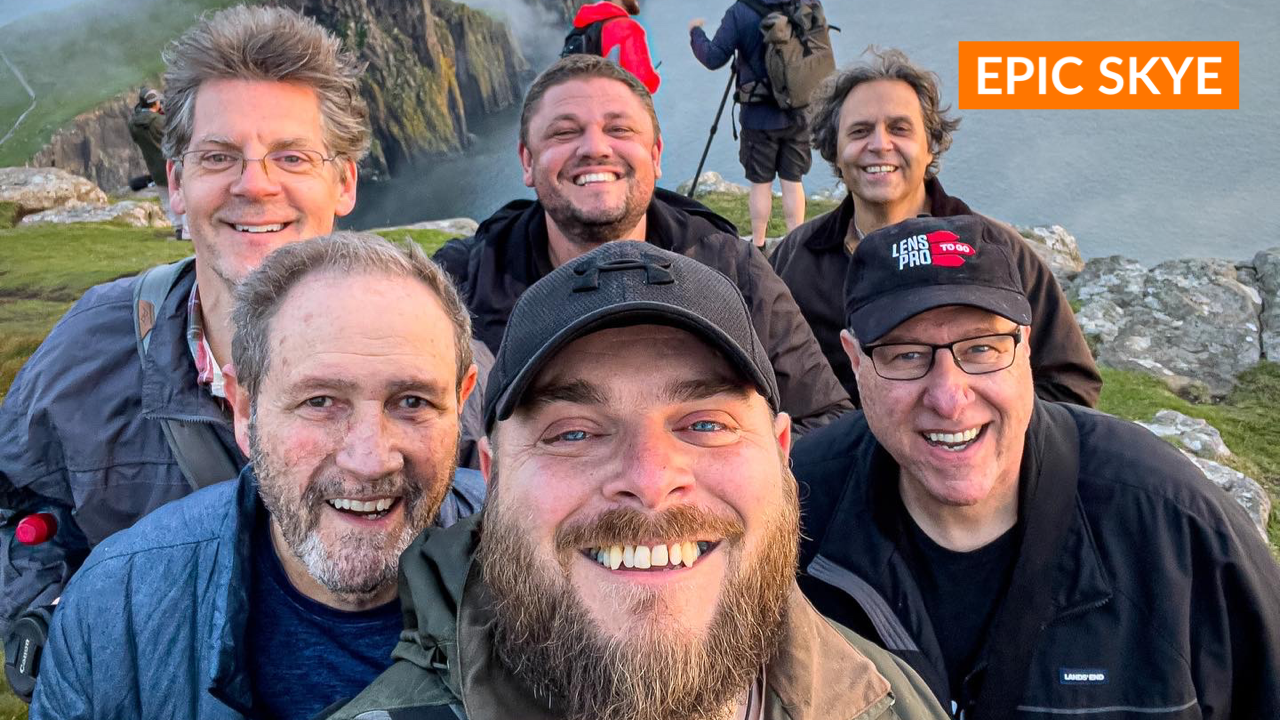If you’re wondering whether you should register for Photoshop World, here are just a few examples of what you might learn, or be inspired by, from our instructors. Below are excerpts from just a few of our favorite Photoshop World instructors’ guest blogs. Click on their names to view the full posts. And if you find inspiration in these, just imagine what’s in store for you at Photoshop World!

Gilmar Smith: Make The Best With What You Have, and Develop A Personal Style
I still work with the first and only camera I’ve ever had. My trusty Canon 5D Mark II. I bought my Elinchrom strobes at around the same time I bought my camera. It was probably September of 2011, and those are still the only ones I have. My computer is about that old too. It even died on me a couple of months ago, and I got a new hard drive, a new battery, turned to YouTube, and fixed it myself. This is proof that when you want something you go for it. I can’t make excuses. I do drool over gear, but I’m supporting two kids on my own and building my empire brick by brick. So, I make the best with what I have.
It goes back to what makes you unique. I get a lot of messages from people asking me how can they jump into the photography business to make a living. And, to be honest, those questions were the inspiration to write this blog post.

I don’t have all the answers. My process hasn’t been easy. I’ve gotten a lot of doors shut on my face, and I’ve had to dust myself off, get up and try again. But I’ve been fully committed all the time.
First, find your niche, then, make your work stand out from the rest. You can only do that by investing long hours on your craft. Try different techniques. There’s no shortcut. Put the hours in and be creative.

Moose Peterson: Passion Tells The story
Where do you start? Well in this instance, you start by first making introductions and the simple portrait. Always working on making the uncommon from the common, we start at the hangar. With nothing more required than a camera and lens, I’ll show you by simply moving a subject back into a hangar you can find dramatic lighting to create that first portrait. That huge door wide open is a great light source and the hangar is a place pilots are very comfortable. Combining the two is how you introduce your skills and passion to the pilot that can lead to so much more, hopefully that air to air photo mission. In our Air to Air class, we also start in the beginning, which means on the ground. Light is what wraps up our visual storytelling and learning that on the ground is essential! How do you do that? You’ll see as we “fly” a model around looking at the light falling on it, the background and then the combo to tell the story. You learn just like the pilots do, in ground school before you take to the air. We’ve laid it all out for you so all you have to do is insert your passion to make it all come to life!

Photographers come to photography often thinking the f/stop, shutter speed and Photoshop are the biggest challenges to be conquered to be successful. Not to scare you, but that’s the easiest and simplest to master in this craft. It’s not till after you think you understand light that the challenge really becomes personal and the mastery creeps along. Because it is then you must invest the most important ingredient for improvement, time! Personal projects where you invest your heart, time and personality to tell the visual story are the true calling of photography. Stories unfold every second of every day around the world providing us all with an opportunity to explore and invest, to fail and succeed in and what I still feel is the grandest pursuit in life. The ball is now in your court to move forward, just remember, passion tells the story!

Kristina Sherk: Retouching in Lightroom vs. Photoshop
Let’s say you want to make five changes to the iris of your model. So – let’s hypothetically think about how we would do that in Photoshop versus Lightroom.
In Photoshop, you would have to create five different adjustment layers in order to make those changes.
1) Color Balance (make eyes more blue)
2) Saturation (make eyes more colorful)
3) Contrast (make highlights and shadows in iris more intense)
4) Sharpen (bring out detail from iris)
5) Curves (make iris brighter)
6) Place all adjustment layers in their own group, and paint the mask in where the effects are meant to be seen.
Gosh – I’m exhausted just typing all of that out! That would easily take a Photoshop newbie at least 10 minutes to do. Now… let’s think about what we would have to do to achieve the same effect in Lightroom.
1) Click on the Local Adjustment brush
2) Drag Temperature, Saturation, Contrast, Sharpness and Exposure Sliders to the desired levels.
3) Paint ONE Stroke on each eye.
And PRESTO! You’re done! I made the same 5 changes to the iris in under 30 seconds (yes – I timed myself), with one tool! This one hypothetical scenario saved the average user nine minutes and 30 seconds! And to take this concept one step further, think about how many photos you retouch per day and you’ll immediately see the time saving benefits of this new way of thinking!
Mark Heaps: Design Thinking
Steve Jobs, and now almost every leader in the modern corporate world, believed that “design thinking” is a pivotal skill for success. Understanding how to solve problems creatively isn’t just some “artist” mindset, it’s a process. One that is taught, and practiced, by some of the biggest firms in the world today. For some, in this modern era, it’s a natural occurrence that is second nature to them. Firms like IDEO and others, really pushed this process into the design of everything and anything. From shopping carts to lamps to logos. Rapidly prototyping their ideas with a fail fast mentality so that as something breaks, they learn from it quickly and course correct. How would you apply this to your own services and value proposition? Even if it’s not a process you put your clients through, it’s something you can put your own ideas through to see if they can stand on their own merit. Evaluate them with peers and see if they have the same outcomes.
The key of Design Thinking is considering the impact, or experience, of the user versus the creator. What will it mean to those who receive the experience versus the experience of the person solving the problem. This alone offers a shift towards empathy of the audience, our brand’s audience.
Empathize: Define and understand the audience.
Define: Make clear exactly the problem to be solved.
Ideate: Brainstorm and aggregate all the ideas you can around the needs.
Prototype: Build a proof of concept from your ideas.
Test: Try it on the media, or with a specific audience, refine and improve.
Kristi Odom: Finding A Big Story in Small Places
The story was getting bigger. I asked a friend and amazing bee photographer (Brooke McDonough) to come and help me document these amazing humans and the mesmerizing insects. Then one day, I got an email from National Geographic: “The story has been approved!” I burst into tears (in all honesty, typing it out right now has put me into tears again). Not only did my dream of getting published in National Geographic come true, but I got to share a story that brought attention to the declining insect population and also highlighted my heroes that taught me just how much we can all make change (a link to the story can be found here).

Revisiting the same park over and over showed me just how much biodiversity there is close to home. From the bird life, frogs, plants, flowers, insects, there is so much to photograph in our own local parks and backyards. We are the best storytellers for our local spaces, and we don’t have to go far to marvel at wildlife. It truly is all around us.

It’s funny how life leads us on a journey. My camera used to sit for way too long in my closet. Now I am creating and marveling at nature almost every day. From the continuous time-lapse going off in my house, to grabbing my camera to check out the owls at a local park. I am constantly creating and connecting to nature. There truly is beauty all around us.
See the full instructor roster, schedule, and register for the conference at PhotoshopWorld.com!






